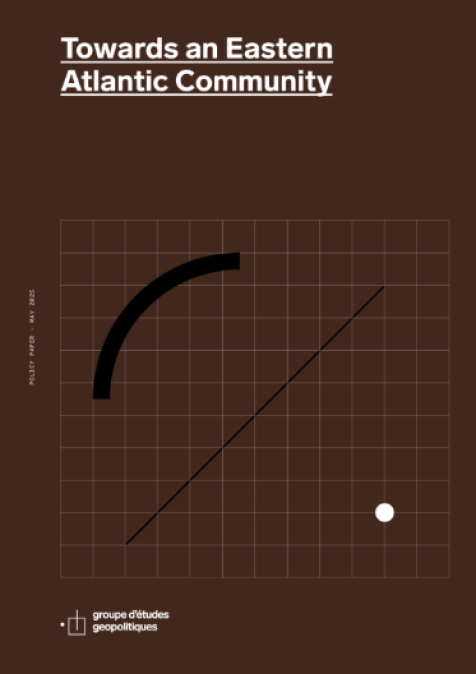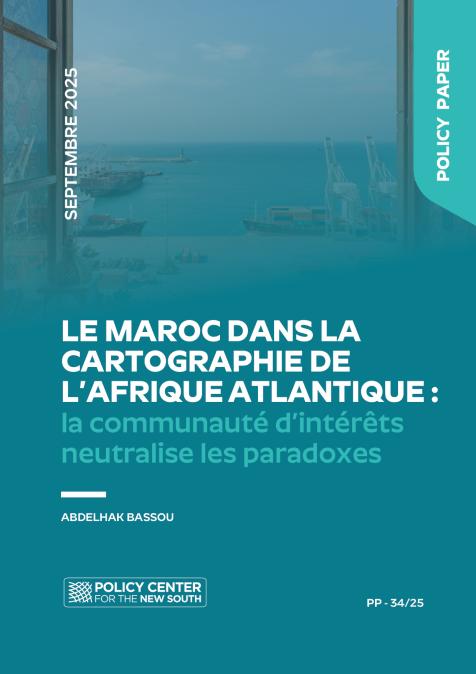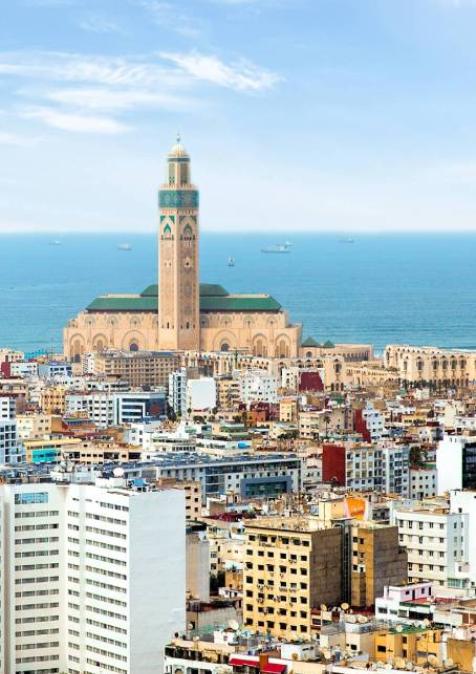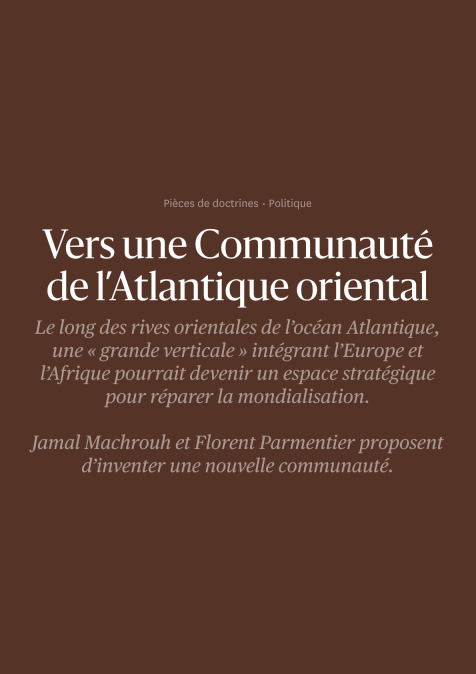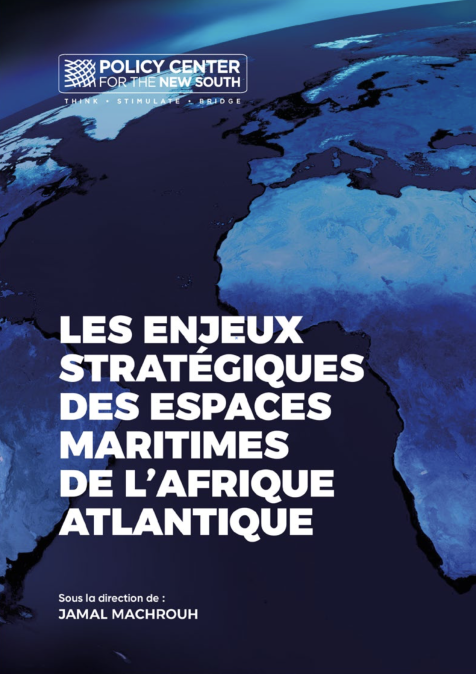Publications /
Policy Brief
This Paper was originally published on geopolitique.eu.
In jointly hosting the 2030 World Cup, Spain, Morocco, and Portugal will pave the way for innovative and unprecedented regional cooperation between Europe and Africa. This “small vertical” initiative should be part of a more innovative and larger scale effort aimed at strengthening ties between the two continents in order to build what could be called an “Eastern Atlantic Community” (EAC).
At a time when vertical cooperation is becoming more established in other parts of the world, such as in the Western Atlantic between the United States, Canada, and Mexico — at least until recently — and in the Pacific between China and Southeast Asian countries, the Eastern Atlantic, an area with significant economic and strategic potential, remains largely overlooked.
This is why a “large vertical” — in other words, the establishment of a structuring geopolitical axis between Europe and Africa along the Atlantic coast — is now a strategic necessity. Based on geographic criteria, at a minimum this community would include the African and European Atlantic coastal nations, ranging from South Africa to Morocco, and from Portugal to Northern Europe.
In this doctrine piece, we will draw attention to the strategic relevance of the Eastern Atlantic Community project, highlight its usefulness for the two partner continents and beyond, and outline its institutional architecture and modus operandi.
In search of a “large vertical”: the strategic need for a new community
In a broken world, the creation of an Eastern Atlantic Community would allow its members to face challenges and seize unique opportunities by coming together around vertical dynamics that are oriented towards and connected to the ocean.
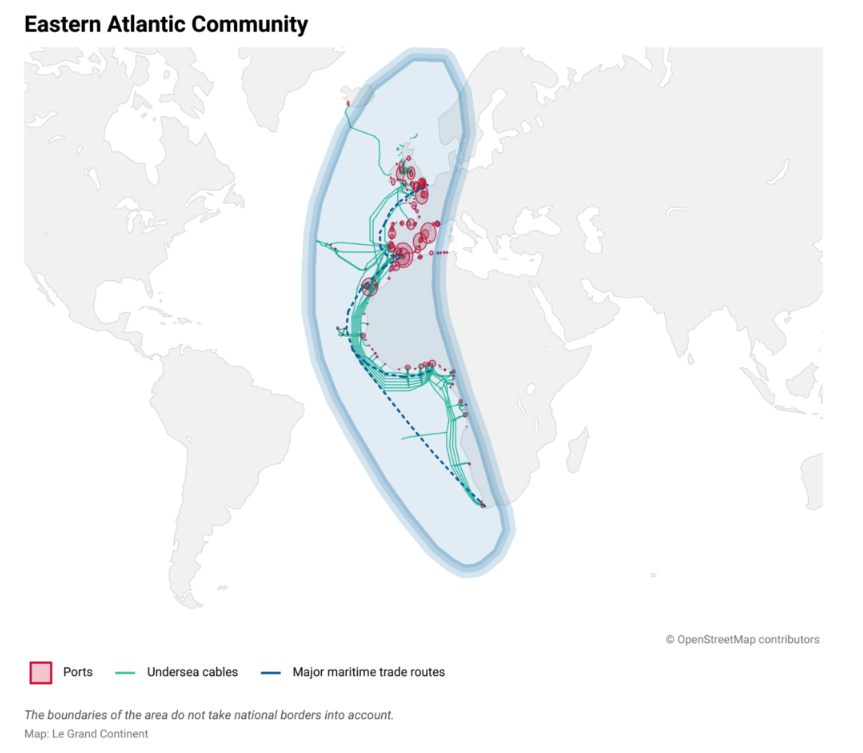
From a broken world to the specter of a strategic shift
The return of high-intensity wars and the rivalry between China and the US carry the risk of both economic decline and political marginalization for Europe and Africa. Both continents, which find themselves in a position of increased strategic vulnerability, should not only prepare to deal with immediate crises, but also seek to advance their interests in a changing world order where their place has yet to be redefined.
China’s rise in power and its ambitious geostrategic initiative, the Belt and Road Initiative, are at the heart of tensions with the US, which have been mounting since Donald Trump returned to the White House. In this “second Cold War,” Europe must reconcile its status as a longtime, unconditional ally of the US while also maintaining its significant economic ties with Beijing and preserving its strategic autonomy. Africa, meanwhile, finds itself being courted by both superpowers: China is pursuing a strategy of massive investment, while the US is attempting to regain influence by supporting development and security cooperation projects.
Faced with these global tensions, the risk of strategic downgrade for Africa and Europe is becoming palpable.
Although economically powerful, it is well known that the EU has struggled to establish itself as a strategic player. Its inability to prevent the war in Ukraine and its difficulties in presenting a united front on the Israeli-Palestinian conflict have fueled doubts about its ability to exert influence in a world order reshaped by the rivalry between China and the US. For Africa, the risk is that it will become more vulnerable to major external shocks, such as global market instability and dependence on food imports. In many respects, African countries do not have the same resilience as the major powers, and their interests could suffer greatly from war becoming once again a tool for managing international relations. 1
A new dynamic for cooperation: the “large vertical”
This “large vertical” would also mirror other cooperative dynamics around the world, with China seeking to drive broad regional integration through the Regional Comprehensive Economic Partnership, while the United States consolidates its economic sphere with the USMCA (United States-Mexico-Canada Agreement).
Against this backdrop, the once central transatlantic axis now appears weakened, and ambitious trans-Pacific and transatlantic partnership projects have been abandoned. Combined with vertical integration strategies, geographical proximity has become a key factor in the reconfiguration of global trade: since 2023, Mexico has overtaken China as the United States’ largest economic partner, and ASEAN is now at the heart of China’s economic priorities.
Faced with regional integration in the American and Asian spaces, the limited cooperation between countries in the Eastern Atlantic region reveals a major strategic lag: in 2024, among the EU’s trading partners, the top African country — Morocco — only ranked eleventh.
The need to build a closer and mutually beneficial relationship between the two continents is becoming urgent, not only for economic reasons but also to address multiple shared challenges, including the energy transition, food security, management of migration, and adaptation to climate change.
For Europe, this means no longer viewing Africa as a vulnerable peripheral region, but as a strategic partner at the heart of future stability.
For Africa and the “new South,” it is a matter of asserting their sovereignty in this cooperative dynamic by defining their priorities and prerequisites.
Connectivity and maritime spaces: mapping global transformation
In a world where 90% of global trade by volume is transported by sea and where the Atlantic plays a vital role, maritime connectivity is a key driver of economic development.
This vital role relies primarily on effective port infrastructure: ports are no longer just transit points but integrated logistics hubs capable of transforming maritime flows into opportunities for local and regional growth.
In this new technical and infrastructural landscape, the Atlantic Ocean could play a key role. 2
In Atlantic Africa, several ports already play a strategic role in the region’s economic development — Lagos in Nigeria, Abidjan in Côte d’Ivoire, and Tema in Ghana — but from a global perspective, the region still faces many challenges: the lack of security on shipping routes, port congestion, the lack of modern infrastructure, piracy, and poor land connectivity with hinterland areas are hampering the development potential of coastal nations and reducing their competitiveness on the global market.
The creation of a “large vertical” is becoming a key strategic issue, and the European Union, with its experience in logistics and maritime transport, could play a key role in financing and supporting strategic port projects in Africa. In return, better connectivity to African ports could offer Europe new trade opportunities and privileged access to strategic resources.
In addition to port logistics, the blue economy represents a tremendous catalyst for development.
The sustainable utilization of marine resources has the potential to generate promising local and regional value chains. This would require strengthening connectivity between ports and their hinterlands through the development of integrated logistics corridors linking major ports to large cities and inland industrial areas. Modern, well-connected ports could reduce the dependence of African economies on imported processed food products by promoting the emergence of local industries that create value within the region, while also stimulating intra-African trade.
Building mutual resilience: economy, energy, strategy
The creation of an Eastern Atlantic Community would thereby be based on mutual resilience, which in the short term could be underpinned by three pillars: the economy, energy, and strategy.
This community would benefit from becoming a genuine strategic partnership, moving towards the pooling of resources and the aggregation of the two regions’ capacities.
Economy
The Eastern Atlantic holds considerable economic potential; with a young population, a growing middle class and an ambitious Free Trade Area (AfCFTA) 3 , Africa represents a promising market for European companies. Growing industrialization, the need for modern infrastructure, and innovation projects in digital and green technologies offer invaluable opportunities. Strengthening its economic ties with Africa would allow Europe to access rapidly growing markets while diversifying its supply chains through friendshoring.
Energy
The energy issue is also central to the resilience of the Eastern Atlantic states.
Boasting significant natural resources, particularly hydrocarbons, as well as considerable potential in renewable energies — solar, wind, hydrogen, and hydroelectric — the African continent would be a strategic partner of choice for Europe, which is confronting the constraints of the energy transition and the need to diversify its supply sources.
The development of an integrated energy network between the two continents, combined with investments in green infrastructure and technologies, could create a virtuous circle of growth and energy security, while reducing the carbon footprint of both regions.
Strategy
Lastly, from a strategic perspective, the creation of an Eastern Atlantic Community seems essential to strengthening both regions’ autonomy in the face of rivalries between major powers.
Avoiding the “strategic fragmentation trap” between the North and the new South
In a context of global strategic deterioration and with relations between the global North and South marked by mutual misunderstandings and historical divisions, it is crucial to avoid the “strategic fragmentation trap.”
Much like the “Thucydides trap” 4 as applied to US-China rivalries, North-South relations could indeed risk entering a dynamic in which international cooperation gives way to conflict, exacerbated by diverging interests and economic asymmetry.
The Eastern Atlantic space offers an opportunity to overcome these tensions by creating a strategic community based on complementary strengths and partnership.
Some still believe in the myth of a homogeneous West and a “global South” united in its demands.
The reality is much more complex.
While the European Union supports an approach that is as multilateral and cooperative as possible, the United States risks oscillating between isolationism and interventionism. As for the new South, it does not necessarily and unanimously reject the West 5 .
Global interest in the emergence of a moderating force
The Eastern Atlantic Community could genuinely represent an innovative space for intercontinental cooperation, transcending traditional divisions and becoming a laboratory for North-South cooperation in the face of major global challenges.
Advances in AI and autonomous technologies, primarily driven by major powers, raise major ethical and strategic questions. A collective approach to innovation, regulation, and technological governance — promoting responsible use of new technologies — could carry more weight in the international debate.
Building on intercontinental initiatives, member states could initiate AI-based solutions to pursue several objectives simultaneously: improving healthcare systems, optimizing supply chains, strengthening food security, and developing shared standards to regulate the use of autonomous technologies, including smart weapons and military AI systems.
Since the countries of the Eastern Atlantic are particularly vulnerable to the effects of climate change — rising sea levels, more intense storms, coastal erosion — establishing climate governance should also be a priority. Cooperation within the Eastern Atlantic Community should focus on environmental resilience, energy transition, the development of a sustainable blue economy, and strengthening coastal resilience.
Bolstered by its geographical and cultural diversity, the Community could play a mediating role in major international crises, offering a neutral, influential, and respected platform for dialogue.
By adopting a pragmatic and innovative approach to cooperation based on complementary economies and the pooling of resources, this community could offer a credible response to major global challenges while avoiding the pitfalls of strategic fragmentation and confrontation between blocs.
Creation of this community would enable the pooling of capabilities in the areas of maritime security, counter-piracy, and management of migratory flows.
Establishing an Eastern Atlantic Community: innovative and minimalist governance centered on a “union of projects”
The Community would benefit from a streamlined and flexible organization designed to adapt to the needs of its members and avoid the bureaucratic burdens inherent to complex organizations.
At the heart of this governance, heads of state and government will play a central role, providing political vision and ensuring that actions are carried out in a coherent manner.
Finally, this Community should be built on a multilateral union of projects involving extensive participation from both the private sector and civil society, with a focus on concrete achievements such as logistics corridors, smart ports, and joint programs for the utilization and preservation of marine resources.
Between forums and regional organizations: a flexible structure
Although the objectives set out for the Eastern Atlantic Community are ambitious, the organizational structures that will need to be put in place to achieve them must be streamlined, agile and pragmatic — because, unfortunately, the inefficiency of international organizations is very often the result of excessive bureaucracy.
The Community could avoid these pitfalls by adopting a resolutely innovative and minimalist governance model. Far from rigid structures, it would be organized as a “union of projects” where priority would be given to concrete actions and measurable results. Each initiative would be led by one or more Member States which would ensure coordination, supported as necessary by experts and technical or financial partners.
Heads of state and government at the heart of governance
Heads of state and government would be at the heart of the community’s governance, gathering at strategic summits held once or twice a year.
The purpose of these meetings would be to collectively define common priorities, identifying key areas for action — infrastructure development, sustainable ocean management, maritime security, cultural exchanges — and to allocate the necessary funding for ongoing projects, whether in the form of national contributions, private investment, or international partnerships. Additionally, these meetings would strengthen political dialogue, promoting mutual understanding and greater coordination between member states when facing major regional and global challenges.
Finally, an essential component would be based on evaluating results: each initiative should be analyzed in terms of its concrete impact with adjustments made as needed in response to emerging challenges and new opportunities, thereby ensuring a dynamic of continuous improvement.
A union of projects: prioritizing concrete actions
Rather than a bloated institution, the Community would function as a flexible platform tailored to the specific needs of concrete projects involving public and private actors, member states, and civil society.
The EAC would stand out for its pragmatic approach, focusing primarily on the following three strategic areas: oceans, energy and climate, and space.
Port connectivity and maritime integration
A port development project could thus be led by an African country, benefiting from European technical expertise and funding to modernize maritime infrastructure and strengthen its logistical capacity and role in international trade. Maritime security in strategic areas such as the Gulf of Guinea could also be strengthened through increased cooperation between the national navies of the two continents, supported by regional organizations such as the European Union and the African Union.
Energy and environment
In terms of energy and climate, the Community could not only strengthen local abilities to deal with environmental emergencies, but also build bridges between researchers, businesses, and governments on both continents to support the energy transition and sustainable practices. At the same time, both sides could join forces to promote their energy sovereignty through the development of energy corridors linking production areas to consumers. Green technology training initiatives could bring together African and European universities to develop joint programs, promoting skills transfer and the emergence of innovative solutions tailored to local challenges.
These ambitions could include the implementation of a strategy for the sustainable extraction of rare metals in order to address the energy and digital transition, based on a spirit of partnership and the shared location of economic activities.
Cooperation in space related matters
Europe and Africa could at last establish a comprehensive and mutually beneficial space cooperation program that addresses key challenges through applications in areas such as food security, environmental sustainability, and regional development.
In this regard, the launch of the African Space Council in April 2025 could pave the way for shaping a dialogue on space solutions for the benefit of all stakeholders.
Inspired by a holistic vision — digital connectivity, space, sustainable trade, green finance, and social inclusion — these examples illustrate the potential of the emerging Eastern Atlantic Community to catalyze synergies and deliver concrete results, meeting the needs of populations while strengthening a strategic partnership between Africa and Europe.
In this model, the Community would act as a linking force, a space for shared prosperity, and a lever for strategic autonomy for both parts of the Eastern Atlantic.
Securing maritime routes in the eastern Atlantic — particularly in the Gulf of Guinea — is crucial to ensuring stable trade and protecting the economic interests of both sides. Similarly, cooperation with regard to defense and crisis management could strengthen regional sovereignty in the face of external interference — Russia’s cyber activities come to mind — which is targeting both Africa and Europe.

